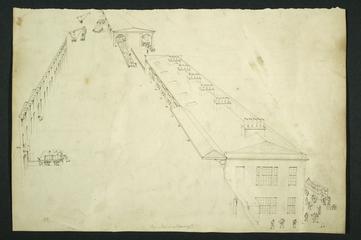
Nasmyth, James Hall 1808 - 1890
- Nationality:
- Scottish
James Hall Nasmyth was born on 19 August 1808 in Edinburgh. He was taught to draw by his father, who was an artist. He used this skill throughout his life. As a boy, he spent a lot of his spare time in an iron foundry owned by a friend of his father. He learned how to use tools, and as a hobby made small steam engines and other types of machinery. He sold some of his models to fund his attendance at classes at Edinburgh University. When he was 19, the Scottish Society of Arts commissioned him to build a steam carriage, which was successfully put into operation on roads around Edinburgh in 1827–8.
In 1829, Nasmyth went to London, where he became assistant to Henry Maudslay, the leading engineering toolmaker of the period, at Maudslay’s Lambeth workshop. Maudslay died in February 1831, and Nasmyth began to work for Maudslay’s partner, Joshua Field. In August 1831, Nasmyth returned to Scotland and began building up a stock of machine in order to set up his own engineering business, which opened in 1834 in Manchester. The small workshop in Dale Street prospered, and in 1836 Nasmyth was able to lease 6 acres of land at Patricroft, where he set up what became the Bridgewater foundry, adjacent to the Bridgewater Canal. He entered into partnership with the local entrepreneur Holbrook Gaskell. Together they developed the business, which acquired a high reputation for the manufacture of a range of machinery, in particular locomotive steam engines and machine tools. In 1839, Nasmyth invented the steam hammer as a tool to speed up the production process, following an order placed to produce the paddle shaft for the SS Great Britain. Nasmyth took out a patent on his design in 1842, and the company became renowned for the production of steam hammers.
From 1843 to 1856 steam hammer production drove the company to prosperity. This success allowed Nasmyth to retire from the company in 1856.
As well as manufacturing machine tools, Nasmyth made important improvements in self-acting controls. While working for Henry Maudslay, he invented a nut-shaping machine. His other inventions and developments include a flexible shaft for driving small drills, and a hydraulic punching machine capable of punching a hole through a block of iron 5 inches thick.
Following his retirement from business in 1856, Nasmyth pursued his interest in astronomy, designing and building his own telescopes. He used his telescopes to survey the moon’s surface. He received a medal from the Great Exhibition of 1851 for his series of drawings of the lunar surface. In 1874, Nasmyth published, in conjunction with James Carpenter, a detailed study entitled The Moon Considered as a Planet, a World, and a Satellite.
Nasmyth died at Bailey's Hotel, Gloucester Road, South Kensington, on 7 May 1890. His ashes were interred at Dean cemetery, Edinburgh.